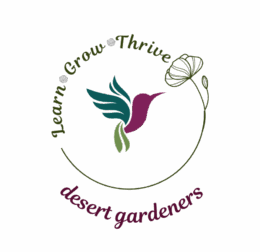You know those helpful little graphics that home garden centers put on their plants that tell you whether they like full sun, shade, or something in between? Those mean entirely different things for a desert gardener.
First, when purchasing a plant, the first thing you need to know is: is it native to the desert in which you live (or a desert next door, so to speak)? For example, in my desert (the Sonoran Desert) many nurseries sell plants from Mediterranean climates, which are billed as “drought tolerant.” Now, Mediterranean climates tend to have rainy winters and dry, hot summers, while my desert has rains during winter and during summer, when the monsoons come. So that’s one difference.
Furthermore, “Mediterranean climate” can be used by different people to mean different regions. Technically, it means regions around the Mediterranean coast, which is hot and sunny BUT importantly also has a fair amount of moisture in the air (because it’s next to a large body of water). The relative humidity there averages around 60% during the day, sometimes more depending on season and weather. Coastal California is also considered to have a Mediterranean climate; the average relative humidity there is around 65-85% in the early mornings and around 60% during the day. Compare that to the average relative humidity in the Sonoran Desert, which is around 10-30% during the day and around 40-50% at night. Deserts in Australia, as well as other North American deserts have similar values.
Thus, native desert plants are naturally accustomed to a much lower humidity level in the air. And there’s another reason that I’m going on about relative humidity: water in the atmosphere has a big influence on how much solar radiation affects your plants. Water vapor refracts sunlight, and also absorbs heat, so the more humid the atmosphere is, the less of the sun’s energy is felt by people, plants, and animals on the ground.
The bottom line here is that those little graphics don’t mean much when it comes to non-native plants. Just because a plant can handle full sun in a Mediterranean climate doesn’t mean it can handle it in the desert.
The best way to solve this issue is of course to plant native plants when possible (see my article on what is a native plant for more info). But even natives have different light requirements. And gardeners also need to consider that cities are generally hotter and have more extreme sun exposure due to sunlight reflecting off buildings, walls, and streets. So here are the sun exposures you should be considering in your yard:
Reflected sun/heat: This is very hard on any plant and will require plants that thrive in the lowest, sunniest parts of the desert. Good examples for the Sonoran Desert include creosote bush, prickly pear cacti and desert willow.
Full sun: This describes native plants that naturally grow at lower elevations on desert plains with sunlight during the entirety of the day.
Part sun/Part shade: This can either mean that the plant will either tolerate some shade, or that it requires some shade, which is a bit nonspecific. It also varies according to the plant—how much shade or sun? It’s not a very helpful designation, but unfortunately it’s widely used. Plants with this designation will require some trial and error.
Afternoon shade: This one is easy, as it means the plant requires shade from the hottest afternoon sun to thrive/survive. These plants are a good choice for eastern exposures with morning sun.
Full shade: This is a plant that requires shade all day. I am hard put to think of any native desert plants that meet this description, but plenty of non-native plants do (even if they’re not labeled as such).
A good resource for finding plants based on sun exposure is the AMWUA “Landscape Plants for the Arizona Desert” handbook. You can also look at the website of the Arizona Native Plant Society and check out their plant list, which is also searchable by sun exposure. Otherwise, your best bet is to look at some gardens in your area and pay attention to what native plants grow and thrive in different areas. This can include botanical gardens but also your local neighborhoods.



